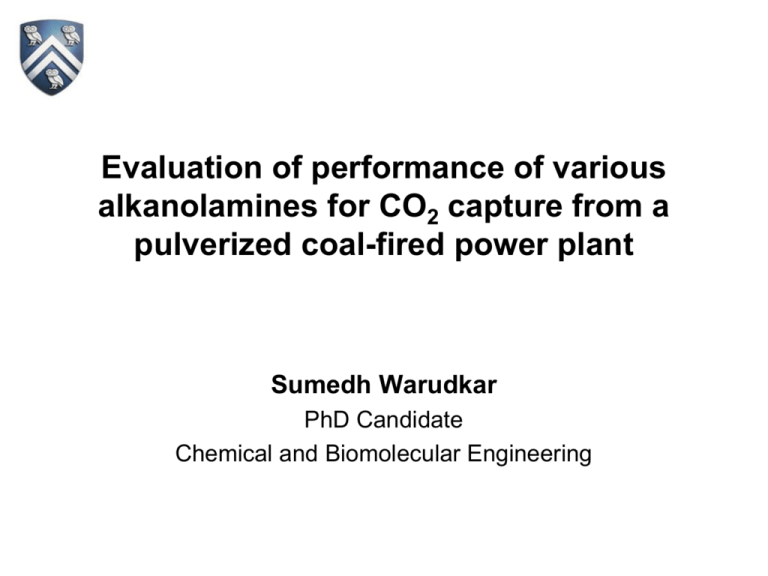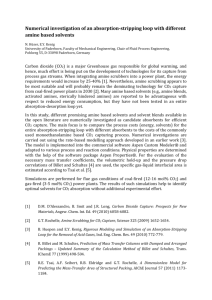Alkanolamines for Carbon Capture
advertisement

Evaluation of performance of various alkanolamines for CO2 capture from a pulverized coal-fired power plant Sumedh Warudkar PhD Candidate Chemical and Biomolecular Engineering Outline • • • • • • • • • The CO2 problem Current CO2 capture technology Scope of Study Amine Absorption Process Comparison of absorbents properties Comparison of Energy Consumption Comparison of Absorber and Stripper Sizing Comparison of Rich Amine Loading Contribution of various processes and utilities to energy consumption • Conclusions The CO2 problem Fig 1. Worldwide energy consumption in TW (2004) Fig 2. Atmospheric CO2 variation (1860-2000) Current CO2 Capture Technology Figure 2.a. Membrane Separation Figure 2.c. Gas Absorption Figure 2.b. Gas Adsorption Scope of Study • With available technology, CCS will increase the cost of electricity from a conventional power plant by 21% - 91%.7 • Current technology for CO2 separation was designed primarily for natural gas sweetening – high pressure feed gas, large variance in acid gas (CO2, H2S) content and generates value added product. • Problem at hand involves power plant flue gas – near atmospheric, low variance in CO2 content and will be a parasitic load for electricity generation utilities. • Due to the low variance in flue gas composition, it might be possible to come up with a generic “best” absorbent for CO2 capture. • Need to better optimize current technology by changing process parameters. Amine Absorption Flow-sheet CO2 compression train Simulation Parameters Composition of coal-fired power plant flue gas [1] Parameter Simulation Parameters Value Parameter Value Absorber – flooding fraction 80% Absorber tray spacing 2 feet Volumetric Flow-rate 1100 MMSCFD Water (mole %) 11.8 Absorber heir weight 3 inches CO2 (mole %) 12.79 Stripper – flooding fraction 80% Oxygen (mole %) 5.6 Stripper – tray spacing 2 feet Nitrogen (mole %) 69.8 Stripper – weir height 3 inches Sulfur Dioxide (mole %) 0.01 Condenser temperature 30 oC Absorber/Stripper Specifications Parameter MEA DGA DEA AMP Absorber - # of Trays 2 2 10 10 Stripper - # of Trays 10 10 10 10 Amine Absorbents Comparison Monoethanolamine (MEA) Diglycolamine (DGA) Advantage Advantage • Primary amine with very high reaction rate with CO2 • Low amine circulation rate • Low molecular weight • High DGA concentrations around 50-70% (wt) can be used due to low volatility • High reaction rate with CO2 • Low amine circulation rate Drawbacks • High heat of reaction • MEA concentrations above 30-35% (wt) are corrosive • Highly corrosive at CO2 loadings above 0.35-0.4 • Highly volatile Diethanolamine (DEA) Drawbacks • High heat of reaction • Highly corrosive at CO2 loadings above 0.35-0.4 2-amino-2-methyl-1-propanol (AMP) Advantage Advantage • Low volatility • Low heat of reaction • High theoretical CO2 loading capacity • Low volatility and few corrosion problems • Low heat of reaction Drawbacks • High amine circulation rate • Secondary amine, low reaction rate • DEA concentrations above 30-35% (wt) are corrosive • Forms highly corrosive at CO2 loadings above 0.350.4. Reacts irreversibly with O2 in flue gas. Drawbacks • Very low reaction rate • High amine circulation rate • High steam consumption to heat amine solution in stripper Reaction Rate Constant & Heat of Reaction Energy Required for CO2 capture Effect of Amine Absorber Entry Temperature (MEA & DEA 40% wt) Energy Required for CO2 capture Comparison of Effect of Stripper Pressure on MEA & DGA Energy Required for CO2 capture Comparison of Effect of Stripper Pressure on DEA & AMP Stripper Diameter Comparison of Effect of Stripper Pressure on MEA & DGA Stripper Diameter Comparison of Effect of Stripper Pressure on DEA & AMP CO2 loading of Rich Amine Loading Comparison of DEA-AMP CO2 loading of Rich Amine Loading Comparison of DEA-AMP Energy Consumption Contribution of various processes and utilities CO2 Compression Effect of stripper pressure on specific volume of compressed vapor and energy consumption Conclusions • • • • • • • 4 amines – MEA, DEA, DGA and AMP were compared to evaluate their performance for CO2 capture application. 3 absorber-stripper train configuration was investigated for 90% CO2 removal from 500 MW coal fired power plant flue gas. This permits estimation of reasonable absorber and stripper sizes. MEA and DGA require only 2 ideal (6 real) stages to achieve 90%+ CO2 capture. DEA requires 10 ideal (30 real) stages to achieve 90% CO2 capture. AMP requires a 10 absorber/stripper train to achieve 90% CO2 capture with reasonable absorber/stripper sizes. Increasing the stripper pressure from 1.5 atm to 3 atm results in a 40% decrease in the energy consumption of CO2 capture (separation + compression) on an average. Compression duty reduces by 25% on an average. Based on these considerations, DGA is the absorbent of choice across all stripper pressures. It has a high reaction rate, it can be used in concentrations up to 60-70% and is non-volatile. Acknowledgements • Prof. George Hirasaki Prof. Mike Wong and Prof. Ken Cox. • Dr. Brad Atkinson and Dr. Peter Krouskop from Bryan Research and Engineering • Loewenstern Graduate Fellowship • Energy and Environmental Systems Institute (EESI) at Rice University • Rice Consortium on Processes in Porous Media • Schlumberger • Office of Dean of Engineering, Rice University • Hirasaki Group & Wong Group members References 1. ProMax Foundations, Bryan Research and Engineering. 2. Vaidya, CO2-Alkanolamine Reaction Kinetics: A review of recent studies, Chem. Eng. Technol (2007), 30, No 11, 1467-1474. 3. Alper, Kinetics of Reactions of Carbon Dioxide with Diglycolamine and Morpholine, Chem. Eng. J, (1990), 44, 107-111. 4. http://msdssearch.dow.com/PublishedLiteratureDOWCOM/dh_017d/0901b8 038017d302.pdf?filepath=amines/pdfs/noreg/11101375.pdf&fromPage=GetDoc 5. http://msdssearch.dow.com/PublishedLiteratureDOWCOM/dh_004e/0901b8 038004e5da.pdf?filepath=angus/pdfs/noreg/31900016.pdf&fromPage=GetDoc 6. http://www.bre.com/portals/0/technicalarticles/Selecting%20Amines%20for %20Sweetening%20Units.pdf 7. D. Aaron and C. Tsouris. Separation of CO2 from flue gas: a review. Separation Science and Technology, 40(1):321, 2005. Questions






